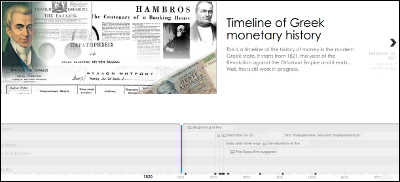As a rule, political economists of the present day do not take the trouble to study the history of money; it is much easier to imagine it and deduce the principles of this imaginary knowledge Alaxander del Mar, A History of monetary systems (1901)
GDP, a problematic indicator

Growth, growth, growth
That was the mantra of the Greek Prime Minister Kostas Simitis in 1999.1 That was the recommendation of the head of the IMF, Domonique Strauss-Kahn, to Giorgos Papandreou in 2010.2 That was the manifesto of the, then, head of the Greek opposition Antonis Samaras in 2011.3 G. Papandreou went so far as to institute a Ministry for Growth a little later.
Growth is a politically charged term. Everyone wishes it and no one refuses it. But what is it?
Technically speaking, "growth" is the annual rate of change in the GDP (Gross Domestic Product). If the GDP increases from 80 units in one year to 81 in the next (usually accountin for inflation), then we have a growth of 1.25%. If it decreases to 79, we have a contraction of 1.25%. But by answering one question, we have raised another: what is GDP?
Creating a statistical indicator
GDP as a statistical measure is the product of state desire to plan the national economy. The first comprehensive steps to its compilation were taken in the United States in 1932 by the Russian-american economist Simon Kuznets, who implemented to an unprecedented extent, methodologies applied in the past only in a fragmentary manner. In the midst of the Great Depression, the American Department of Commerce tasked him with the compilation of a tool that would measure succinctly the state of the national economy. Kuznets, working on secondement from the National Bureau of Economic Research, proceeded to meticulously record a great series of income streams and to distill them to a single number, the National Income (or Net National Income, NNI), which was derived from the sum of the net market prices4 of all products sold and services rendered from American nationals, within or outside the US. He thus tried to "describe the total activity of the national economy under one aspect, viz., the size of the final net product".5
The problems
Kuznets himself was unequivocal about the utility, the meaning, and the limitations of the tool he had just created. As he stated before the US Congress in 1934,6 many productive activities that are carried out without exchange of money are not recorded in his tables, while many recorded incomes do not account for really productive activities; some actually account for disasters. He himself used the classic example of housewives, whose contribution to the national product he characterised as "imposing", which, however, was impossible to account for as it was not provided for a monetary reward.7 A corrolary to this condition is the witty, but entirely precise, statement that when someone marries his au pair he decreases the national income. Kuznets provided additional examples: of products and services that are consumed or rendered without exchange of money (living in one's own house), services that are paid but are not declared (odd jobs and illegal activities), payments made irrespective of a service (charity) and activities (legal or illegal) that are carried out through exchange of money, but which do not promote general prosperity.
As a good statistician, Kuznets starts his description from what his tool does not do and from its possible "uses and abuses". He clarifies that the simplicity and accurracy of a number is nothing but an illusion. The national income may measure meaningfully the relative differences between different states at the sime time, or the time evolution of a specific state, but taking into account the above mentioned limitations: that it takes into account activities within the market of an economy, and not the economy as a whole. In other words, Kuznets considers the market as a subset of the economy; consequently, this number cannot measure the general prosperity of the economy of a nation.8
The political decision
On a political level, Kuznets preferred an "enlightened social philosophy" that would deduct destructive and not productive activities from the measurement of the national income, such as armaments, speculation, as well as great public infrastructure works that exist to make life easier.9 But with war approaching, this view which excluded government spending from productive activities was not so popular, since war spending would decrease the National Income. What was required was an indicator which would not present this inconveniency. In the 1937 edition, Kuznets would speak if the Gross National Product (GNP),10 an indicator that took into account the gross spending (including production cost) of a country's nationals, within or outside its territory. This indicator had been previously been proposed by Clark Warburton, and it included state spending.11 As of 1944, after the Bretton Woods conference, the Gross Domestic Product (GDP)12 would gradually become the most popular indicator, a process that would start arounf 1954-55 in Greece.13
Even if the two indicators are not identical, they prescribe a common statistical methodology. Therefore they share the same limitations. Consequently, GDP is a statistical indicator that, on one hand, cannot be accurately measured, and which, on the other hand, does not necessarily reflect social prosperity. Moreover, it fluctuates as its "correct" calculation undergoes periodic, and often radical, changes.14 Finally, even within the context of the "correct" methodology, politically motivated tampering cannot be excluded. One of the first exceptions that Kuznets mentioned in 1934 would be turned on its head in 2006 when Giorgos Alogoskoufis, the Greek Finance Minister at the time, would include prostitution in the Greek GDP. and much as he was mocked and derised at the time, Eurostat would imitate him in 2014.
References
1 On 2/3/1999, after the end of the European Socialist Party (Rizospastis, 3/3/1999, http://www1.rizospastis.gr/storyPlain.do?id=3763419).
2 On 7/12/2010, during a visit to G. Papandreou (Capital.gr, 8/12/2010, http://www.capital.gr/stoupas/Article.aspx?id=1100098).
3 Session minutes of the Greek Parliament, 16/3/2011, p. 7576 (http://www.hellenicparliament.gr/UserFiles/a08fc2dd-61a9-4a83-b09a-09f4c564609d/es20110316%20(proi).pdf). Also, http://www.hellenicparliament.gr/UserFiles/a08fc2dd-61a9-4a83-b09a-09f4c564609d/es110316pr_1.doc, p. 18).
4 I.e., market sale price minus cost of production.
5 Simon Kuznets, National income 1929-1932, National Bureau of Economic Research, Bulletin 49, 7/6/1934 (www.nber.org/chapters/c2258.pdf).
6 National Income, 1929-1932, Senate Document No 124, 73d Congress, 2d Session.
7 National Income, 1929-1932, Senate Document No 124, σελ. 4-5.
8 National Income, 1929-1932, Senate Document No 124, σελ. 5-6.
9 Simon Kuznets, Concepts of national income, Discussion, σελ. 37 (http://www.nber.org/chapters/c8136.pdf). Fropm the collective: Studies in Income and Wealth, Volume 1, Conference on Research in Income and Wealth - National Bureau of Economic Research, New York 1937 (http://papers.nber.org/books/unkn37-1).
10 Simon Kuznets, National income and capital formation 1919-1935, National Bureau of Economic Research, New York 1937 ( http://www.nber.org/books/kuzn37-1).
11 Clark Warburton, Value of the Gross National Product and Its Components, 1919-1929, Journal of the American Statistical Association, 1934, 29, 383-388.
12 Regards the inhabitants of the national territory irrespective of nationality.
13 See e.g.: (a) Bank of Greece, Governor's report for 1954, p. 11 (published in April 1955). (b) Greek National Statistical Service (ESYE), Concise Statistical Yearbook of Greece for 1954, p. 170.
14 Up till 1988, Greece used the OECD 1958 system of accounts. The EEC/EURATOM Directive 89/130 of 13/2/1989 obliged the member-states to adopt the 1979 European System of Integrated Accounts (ESA 79). In Greece, the first year using the revised system was 1988. The result was a 20% overnight increase in the Greek GDP. As of April 1996 (EU regulation 2223/96 of 25/6/1996) the member-states were obliged to adopt the new ESA 95 system. The first year of its use in Greece regarded the 1995 data, which were first published in 1999. (βλ. Grigoris Grigoriadiw, The Greek GDP (1980-1999). Structure and evolution - Tendencies and conclusions, http://www.kke.gr/2000_4/to_aep_ths_xoras_1980-1999_domh_kai_ekseliksh-taseis_kai_symperasmata).





Add new comment